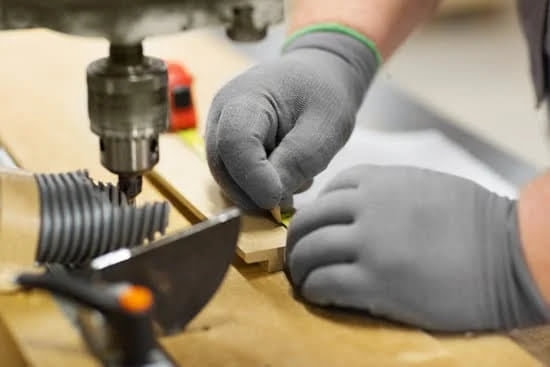Introduction
Woodworking inlay is a decorative process in which materials such as wood, metal, stone, ivory or shell are inserted into the surface of a piece of furniture or craft object. It adds visual interest and texture to a project while bringing light to otherwise dull surfaces. The materials used for inlay can also be painted, gilded and lacquered for additional effects. There are many benefits to using this technique in furniture making and crafted objects; not only does it enhance the beauty and uniqueness of the individual pieces but it can also increase their value as collectibles or heirloom items. Additionally, through its intricate detail work, an artist may achieve complex curves, framing shapes and various architectural features that add even more aesthetic appeal to any given piece. Lastly, no two pieces will ever be exactly alike due to one-of-a-kind design options provided by this method.
History and Origins
The tradition of woodworking inlay can be traced back thousands of years, with numerous cultures around the world using this technique to create beautiful and ornate pieces for decorative or functional purposes. Probably the most famous examples of this craft are from the ancient Egyptians and Greeks, who used it in palace decoration, furniture and other artwork. During the Middle Ages, woodworking inlay was a popular form of art with workshops producing intricate designs for churches and castles. In modern times, woodworking inlay is still highly versatile; from simple borders to intricate designs that require time and precision.
Woodworking inlay has long been associated with high-end furniture and cabinetry due to its delicate nature and immense difficulty. Throughout the centuries, inlay work has become increasingly more refined as skilled artisans continue to push the boundaries on intricacy and detail. This type of craftsmanship requires a keen eye for color combinations as well as tools such as chisels, glue presses, heat guns and carving tools to get into those further corners.
While initially used only by more elite craftsmen during the height of its popularity hundreds of years ago, advances in technology have now enabled amateur enthusiasts to take up creating these smaller details at home if they desire. Interested individuals can join classes or learn through youtube tutorials about processes such as marquetry or intarsia- shaping thin pieces of wood into puzzles by hand-cut joints which are then glued together to make patterns or figures. Also available are pre-made kits that come with all necessary supplies so anyone can get started quickly!
Process Overview
1. Begin by selecting a piece of wood, such as a board with a unique grain pattern that can be used for the inlay.
2. Reference the design of your inlay before cutting it out according to its shape and size from the chosen piece of wood.
3. Cut out a recess in the baseboard as deep as the thickness of the inlay material to fit the newly cut piece into it. Take your time during this step to ensure accuracy and evenness of depth throughout the entire recess area.
4. Create an outline around the perimeter of the recess using either a router or hand-cutter and follow up by chiseling and shimming this line away until you have reached your desired depth.
5. Glue down your prepared inlay material into the section and let it sit overnight while excess glue is trimmed away with a sharp tool like a chisel once dry..
6. Sand down flush any high spots within or around your inlay using fine-grit sandpaper to level off any remaining imperfections created during installation work.
7. Stain or finish the entire surface onto match other surfaces located inclose proximity so that there is no noticeable difference between them upon completion..
Materials and Tools
Woodworking inlay can involve a variety of materials and tools depending on the effect desired. Many traditional types of inlay involve small pieces of wood, metal, or plastic which are used to fill voids or produce decorative accents within a larger piece. To achieve a quality inlay requires the use of several tools including saws, chisels, router bits, clamps and files. Wood glue is often necessary as well as various forms of sandpaper in various grain sizes. Additionally, finishes such as shellac and lacquer are often employed to further enhance the beauty of the finished piece. For metal and plastic inlays more specialized tools may be required to cut precise shapes for a meaningful design.
Common Issues and Solutions
One common issue that arises while woodworking inlay is cracking. This usually occurs when too much force has been applied to the inlay, which causes the piece to either crack or break off from the main piece of wood.
The best way to avoid this problem altogether is by using high quality cutting tools and applying even pressure when cutting the inlay piece so it can fit perfectly in its intended space without having to force it into place. Another helpful tip is to secure edges with clamps or tapes before cutting in order to prevent any damage. Additionally, using thinner pieces as opposed to thicker pieces of material for inlays also reduces the likelihood of cracks and splinters.
Another common issue that frequently occurs is mismatched materials. Woodworkers may use too many different types and thicknesses of materials, resulting in a jumbled and uneven woodworking project upon completion. To avoid this problem, it’s important to select only one type of material and stick with it while working on your project. Additionally, make sure all pieces are cut properly and to uniform measurements so they will fit together seamlessly after assembly.
Finally, glue seepage can be an annoying problem when attempting woodworking inlay projects; but thankfully there are several solutions available to help combat this issue. Make sure you are using an appropriate glue for your project type and clean up any excess residue immediately before letting it dry completely. After that’s done, sand down any areas where adhesive has leaked out until smooth, then reapply the desired amount before pressing the inlay piece into place again.
Examples of Woodworking Inlay
Woodworking inlay is a practice that has been utilized for centuries to create breathtakingly beautiful works of art. It involves the bonding of two or more materials, such as wood, metal, stone or even ivory. Traditionally, intricate patterns and designs are carved directly into the surface of the material to form a complex overlap with the design elements. This creates a dynamic look and allows for unique visual effects.
The appeal of this art form lies in its versatility and availability from cultures around the world. For example, Chinese tradition has long included beautifully made inlays ” often with jade edging ” while Russian culture debates on the technique’s origin due to royal decorations adorning items during their Tsarist period. In West Africa too there is evidence of ancient pieces inlayed with mother-of-pearl and other exotic materials, while some Bedouin artifacts show geometric shapes cleverly crafted into one piece.
Today, woodworking inlay is still widely practiced yet comes in an incredible range of styles and materials depending on personal tastes and preferences. Examples include wooden pathways with metal chips or strips imbedded along one edge; backgammon boards created with interlocking motley stones; musical instruments adorned with conch shells; furniture designs featuring turquoise accents; jewelry boxes decorated with French ivory etchings; chess pieces surrounded by green malachite gemstones; marquetry creations from small offcuts of centuries old hardwoods; tables highlighted by creamy marble edges and much more!
Tips and Tricks
Woodworking inlay is an excellent way to make a piece of furniture or decorative item stand out. There are many different types of woodworking inlay that can be used, including turquoise, corals, stones, metals, and woods. Working with an experienced craftsman is the best way to make sure your project looks its best. Here are some tips and tricks from experts that will help you create beautiful woodworking inlays:
1) Choose the right materials for your project – Research the type of wood you are working with and make sure you select materials that compliment its texture and color. Try to find colors or textures that will bring out the natural beauty of the wood.
2) Prepare the surface – Before beginning your inlay work, make sure to properly sand and prepare the surface. Smooth surfaces allow for a better finished product.
3) Take measurements – Accurate measurements are essential for successful inlay projects. Measure twice before you cut once! It’s also important to measure your material before cutting it so that you don’t accidentally cut too much off.
4) Secure Materials with Glue – You want to be sure all pieces are secure when creating an inlay pattern. Use glue sparingly but cover each piece securely so they won’t come apart during further use or removal later on.
5) Seal The Project – Once the inlaying process has been completed, seal your project with a protective coat such as polyurethane or lacquer to protect the wood from damage over time and enhance its look at the same time.
Maintenance
Woodworking inlay is a popular technique that can add an element of beauty to any project. To maintain the quality and luster of your inlay, it is important to clean any excess dust or dirt with a damp cloth. Additionally, taking steps to protect the inlay from moisture exposure can extend its life, such as placing it away from sources of humidity like sinks or bathrooms and keeping wood surfaces treated with sealing products like varnish, lacquer and shellac. Utilizing coasters can also help maintain its quality by protecting it from spills. When moving or storing the piece, make sure to use padding so there will be no contact between the hard materials that could cause scratches or indentations. Finally, if you notice that your inlay needs repairs due to damage over time; utilizing a qualified carpenter may be able to help restore its original condition.
Conclusion
Woodworking inlay is a traditional technique used to create intricate and beautiful designs on furniture pieces. It involves embodying colored materials such as stones, metal, wood, plastics, and veneers within wood structures. The finished product creates interesting patterns that can be used to add unique detail to furniture pieces.
The benefits of woodworking inlay are numerous and varied. First, it can be used to create aesthetically pleasing visual effects that liven up any décor or setting. Second, it adds a certain level of strength to furniture by filling gaps and cracks between joints while also placing less strain on the integrity of the wood itself. Third, it’s a great way to add texture and color which enhances design elements like texture or contrast. Finally, it helps to preserve the longevity of furniture through susing strong adhesives that keep the inlaid material firmly attached for many years of use.
For these reasons, woodworking inlay is a popular finish choice among hobbyists, home decorators and professional craftsmen alike; its ability to add detail, color and strength makes it an excellent option for anyone wanting to achieve an eye-catching end result with long-term durability.

Hi everyone! I’m a woodworker and blogger, and this is my woodworking blog. In my blog, I share tips and tricks for woodworkers of all skill levels, as well as project ideas that you can try yourself.





